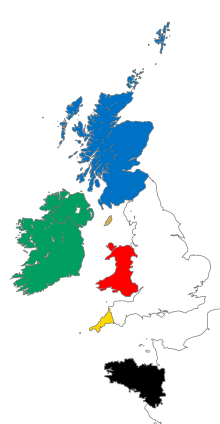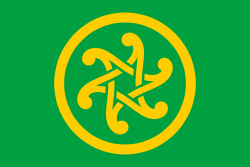Irish people
The Irish (Irish: Muintir na hÉireann or Na hÉireannaigh) are a nation and ethnic group native to the island of Ireland, who share a common Irish ancestry, identity and culture. Ireland has been inhabited for about 12,500 years according to archaeological studies (see Prehistoric Ireland). For most of Ireland's recorded history, the Irish have been primarily a Gaelic people (see Gaelic Ireland). From the 9th century, small numbers of Vikings settled in Ireland, becoming the Norse-Gaels. Anglo-Normans conquered parts of Ireland in the 12th century, while England's 16th/17th-century (re)conquest and colonisation of Ireland brought many English and Lowland Scots people to parts of the island, especially the north. Today, Ireland is made up of the Republic of Ireland (an independent state) and the smaller Northern Ireland (a part of the United Kingdom). The people of Northern Ireland hold various national identities including British, Irish, Northern Irish or some combination thereof.
| Total population | |
|---|---|
c. 70–80 million worldwide[1]
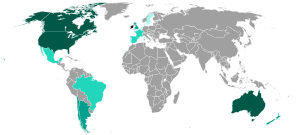 | |
| Regions with significant populations | |
| Northern Ireland 1,810,863 (2011)[3] | |
| 40,000,000+[4] | |
| 650,000 first generation[5] | |
| 7,000,000[6] | |
| 4,544,870[7] | |
| 600,000[8] | |
| 500,000[9] | |
| 120,000[10] | |
| 15,000[11] | |
| Languages | |
| Irish, English (Hiberno-English dialects), Scots (Ulster Scots dialects), Shelta | |
| Religion | |
| Mainly Christianity (majority Roman Catholicism; minority Protestantism, especially Presbyterianism, Anglicanism, Methodism) see also: Religion in Ireland | |
| Related ethnic groups | |
| Irish Travellers, Gaels, Anglo-Irish, Bretons, Cornish, English, Icelanders,[12] Manx, Norse, Scots, Ulster Scots, Welsh | |
| Part of a series on |
| Irish people |
|---|
.gif) |
| By region or country |
|
Republic of Ireland · Northern Ireland Irish diaspora · Irish Travellers |
| Irish culture |
|
Art · Calendar · Cinema · Clans Cuisine · Dance · Dress Education (ROI) · Education (NI) · Flags Languages · Literature · Mythology Music · Politics (ROI) · Politics (NI) Religion (ROI) · Religion (NI) · Sport · Television |
| Religion |
|
Catholicism · Church of Ireland Presbyterianism · Methodism Judaism · Islam · Paganism |
| Languages and dialects |
|
Irish · Hiberno-English Ulster Scots · Shelta |
| History of Ireland |
| Part of a series on the |
| Culture of Ireland |
|---|
 |
| History |
| People |
|
|
Cuisine
|
| Religion |
| Art |
| Literature |
|
Music and performing arts
|
|
Media
|
|
Monuments |
|
Symbols
|
|
The Irish have their own customs, language, music, dance, sports, cuisine and mythology. Although Irish (Gaeilge) was their main language in the past, today most Irish people speak English as their first language. Historically, the Irish nation was made up of kin groups or clans, and the Irish also had their own religion, law code, alphabet and style of dress.
There have been many notable Irish people throughout history. After Ireland's conversion to Christianity, Irish missionaries and scholars exerted great influence on Western Europe, and the Irish came to be seen as a nation of "saints and scholars". The 6th-century Irish monk and missionary Columbanus is regarded as one of the "fathers of Europe",[13] followed by saints Cillian and Fergal. The scientist Robert Boyle is considered the "father of chemistry", and Robert Mallet one of the "fathers of seismology". Famous Irish writers include Oscar Wilde, W. B. Yeats, Samuel Beckett, George Bernard Shaw, Bram Stoker, James Joyce, C.S. Lewis and Seamus Heaney. Notable Irish explorers include Brendan the Navigator, Sir Robert McClure, Sir Alexander Armstrong, Sir Ernest Shackleton and Tom Crean. By some accounts, the first European child born in North America had Irish descent on both sides.[14] Many presidents of the United States have had some Irish ancestry.
The population of Ireland is about 6.3 million, but it is estimated that 50 to 80 million people around the world have Irish forebears, making the Irish diaspora one of the largest of any nation. Historically, emigration from Ireland has been the result of conflict, famine and economic issues. People of Irish descent are found mainly in English-speaking countries, especially Great Britain, the United States, Canada and Australia. There are also significant numbers in Argentina, Mexico, New Zealand and Brazil. The United States has the most people of Irish descent, while in Australia those of Irish descent are a higher percentage of the population than in any other country outside Ireland.[15] Many Icelanders have Irish and Scottish Gaelic forebears.[16]
Origins and antecedents
Prehistoric and legendary ancestors
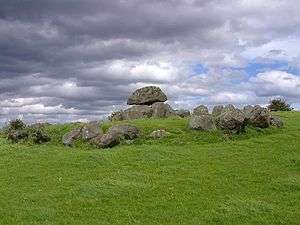
During the past 12,500 years of inhabitation, Ireland has witnessed some different peoples arrive on its shores. The ancient peoples of Ireland—such as the creators of the Céide Fields and Newgrange—are almost unknown. Neither their languages nor the terms they used to describe themselves have survived.
Ireland itself was known by a number of different names, including Banba, Fódla, Ériu by the islanders, Iouerne and Hiverne to the Greeks, and Hibernia to the Romans.
Pytheas made a voyage of exploration to northwestern Europe in about 325 BC, but his account of it, known widely in Antiquity, has not survived and is now known only through the writings of others. On this voyage, he circumnavigated and visited a considerable part of modern-day Great Britain and Ireland. He was the first known scientific visitor to see and describe the Celtic and Germanic tribes.[17] "Britain" is most like Welsh Ynys Prydein, "the island of Britain", in which is a P-Celtic allophone of Q-Celtic Cruithne in Irish Cruithen-tuath, "land of the Picts". The base word is Scottish/Irish cruth, Welsh pryd, meaning "form". The British were the "people of forms", with the sense of shapes or pictures,[18] thought to refer to their practice of tattooing or war painting.[19] The Roman word Picti, "the Picts", means "painted". This etymology shows that Pytheas interacted not so much with Irish, as they used Q-Celtic. Rather, Pytheas brought back the P-Celtic form from more geographically accessible regions where Welsh or Breton are spoken presently. Furthermore, some proto-Celtic was spoken over all of Greater Britain, and this particular spelling is prototypical of those more populous regions. Diodorus, based on Pytheas reports that Britain is cold and subject to frosts, being "too much subject to the Bear", and not "under the Arctic pole", as some translations say.[20] The numerous population of natives, he says, live in thatched cottages, store their grain in subterranean caches and bake bread from it.[20] They are "of simple manners" (ēthesin haplous) and are content with plain fare. They are ruled by many kings and princes who live in peace with each other. Their troops fight from chariots, as did the Greeks in the Trojan War.
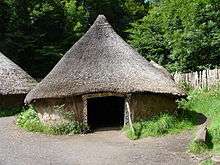
Scotland takes its name from Scota, who in Irish mythology, Scottish mythology, and pseudohistory, is the name given to two different mythological daughters of two different Egyptian Pharaohs to whom the Gaels traced their ancestry, allegedly explaining the name Scoti, applied by the Romans to Irish raiders, and later to the Irish invaders of Argyll and Caledonia which became known as Scotland. Other Latin names for people from Ireland in Classic and Mediaeval sources include Attacotti and Gael. This last word, derived from the Welsh gwyddel "raiders", was eventually adopted by the Irish for themselves. However, as a term it is on a par with Viking, as it describes an activity (raiding, piracy) and its proponents, not their actual ethnic affiliations.
The terms Irish and Ireland are probably derived from the goddess Ériu.[21] A variety of historical ethnic groups have inhabited the island, including the Airgialla, Fir Ol nEchmacht, Delbhna, Fir Bolg, Érainn, Eóganachta, Mairtine, Conmaicne, Soghain, and Ulaid. In the cases of the Conmaicne, Delbhna, and perhaps Érainn, it can be demonstrated that the tribe took their name from their chief deity, or in the case of the Ciannachta, Eóganachta, and possibly the Soghain, a deified ancestor. This practice is paralleled by the Anglo-Saxon dynasties' claims of descent from Woden, via his sons Wecta, Baeldaeg, Casere and Wihtlaeg.
The Greek mythographer Euhemerus originated the concept of Euhemerism, which treats mythological accounts as a reflection of actual historical events shaped by retelling and traditional mores. In the 12th century, Icelandic bard and historian Snorri Sturluson proposed that the Norse gods were originally historical war leaders and kings, who later became cult figures, eventually set into society as gods. This view is in agreement with Irish historians such as T. F. O'Rahilly and Francis John Byrne; the early chapters of their respective books, Early Irish history and mythology (reprinted 2004) and Irish Kings and High-Kings (3rd revised edition, 2001), deal in depth with the origins and status of many Irish ancestral deities.
One legend states that the Irish were descended from one Míl Espáine, whose sons supposedly conquered Ireland around 1000 BC or later.[22] The character is almost certainly a mere personification of a supposed migration by a group or groups from Iberia to Ireland. It is from this that the Irish were, as late as the 1800s, popularly known as "Milesian".[23] Medieval Irish historians, over the course of several centuries, created the genealogical dogma that all Irish were descendants of Míl, ignoring the fact that their own works demonstrated inhabitants in Ireland prior to his supposed arrival.
This doctrine was adapted between the 10th and 12th centuries, as demonstrated in the works of Eochaidh Ua Floinn (936–1004); Flann Mainistrech (died 25 November 1056); Tanaide (died c. 1075) and Gilla Cómáin mac Gilla Samthainde (fl. 1072). Many of their compositions were incorporated into the compendium Lebor Gabála Érenn.
This tradition was enhanced and embedded in the tradition by successive historians such as Dubsúilech Ó Maolconaire (died 1270); Seán Mór Ó Dubhagáin (d.1372); Giolla Íosa Mór Mac Fir Bhisigh (fl. 1390–1418); Pilip Ballach Ó Duibhgeannáin (fl. 1579–1590) and Flann Mac Aodhagáin (alive 1640). The first Irish historian who questioned the reliability of such accounts was Dubhaltach Mac Fhirbhisigh (murdered 1671).
Genetics
Genetic research shows a strong similarity between the Y chromosome haplotypes of Irish men with Goidelic surnames, and males from the area of Spain and Portugal, especially Galicia, Asturias, and Cantabria (and perhaps former Basque country).[24] The incidence of the R1b-M269 haplogroup is 70% or more in Ireland, Cumbria and Cornwall in England, the Northern region in Portugal (Douro Litoral, Minho and Trás-os-Montes e Alto Douro), northern Spain (Galicia, Asturias, León, Cantabria and Basque Country), western France (Gascony, Saintonge, Poitou, and Brittany), and Wales and Scotland in Britain. R1b-M269's incidence declines gradually with distance from these areas but it is still common across the central areas of Europe. R1b-M269 is the most frequent haplogroup in Germany and in the Low Countries, and is common in southern Scandinavia and in northern and central Italy.[25][26]
However, this haplogroup is now believed to have originated over 12,000 years more recently than previously thought, at only 5,000 years ago.[27] According to 2009 studies by Bramanti et al. and Malmström et al. on mtDNA,[28][29] related western European populations appear to be largely from the neolithic and not paleolithic era, as previously thought. There was discontinuity between mesolithic central Europe and modern European populations mainly due to an extremely high frequency of haplogroup U (particularly U5) types in mesolithic central European sites.
The existence of an especially strong genetic association between the Irish and the Basques was first challenged in 2005,[30] and in 2007 scientists began looking at the possibility of a more recent Mesolithic- or even Neolithic-era entrance of R1b into Europe.[31] A new study published in 2010 by Balaresque et al. implies either a Mesolithic- or Neolithic- (not Paleolithic-) era entrance of R1b into Europe.[32] Unlike previous studies, large sections of autosomal DNA were analyzed in addition to paternal Y-DNA markers. They detected an autosomal component present in modern Europeans which was not present in Neolithic or Mesolithic Europeans, and which would have been introduced into Europe with paternal lineages R1b and R1a, as well as the Indo-European languages. This genetic component, labelled as "Yamnaya" in the studies, then mixed to varying degrees with earlier Mesolithic hunter-gatherer and/or Neolithic farmer populations already existing in western Europe.[33][34][35] A more recent whole genome analysis of Neolithic and Bronze Age skeletal remains from Ireland suggested that the original Neolithic farming population was most similar to present-day Sardinians, while the three Bronze Age remains had a large genetic component from the Pontic-Caspian Steppe. Modern Irish are the population most genetically similar to the Bronze Age remains, followed by Scottish and Welsh, and share more DNA with the three Bronze Age men from Rathlin Island than with the earlier Ballynahatty Neolithic woman.[36][37]
A 2017 genetic study done on the Irish shows that there is fine-scale population structure between different regional populations of the island, with the largest difference between native 'Gaelic' Irish populations and those of Northern Ireland known to have recent, partial British ancestry. They were also found to have most similarity to two main ancestral sources: a 'French' component (mostly northwestern French) which reached highest levels in the Irish and other Celtic populations (Welsh, Highland Scots and Cornish) and showing a possible link to the Bretons; and a 'West Norwegian' component related to the Viking era.[38][39]
Black Irish
Black Irish is an ambiguous term sometimes used (mainly outside Ireland) as a reference to a dark-haired phenotype appearing in people of Irish origin.[40] However, dark hair in people of Irish descent is common, although darker skin complexions appear less frequently.[41] One popular speculation suggests the Black Irish are descendants of survivors of the Spanish Armada, multiple ships from which were wrecked or made landfall on the western Irish coast in 1588; subsequent research has discredited such claims.[42] Filmmaker Bob Quinn, in the documentary series Atlantean, hypothesises the existence of an ancient sea-trading route linking North Africa and Iberia to regions such as Connemara. With this hypothesis, Quinn explains phenotypical similarities between the "Atlantean Irish" and the populations of Iberia and the Berbers.[43] Quinn's Atlantean thesis has not been accepted by the Irish academic establishment, who have criticised it is as non-scholarly and lacking hard evidence to back his theories.[44]
Afro-Caribbean people descended from Irish settlers in the Caribbean, especially those on Barbados and Montserrat,[45] are also referred to as "Black Irish". The people concerned often have Irish surnames, speak a form of Caribbean English influenced by the Irish vernacular and, in some cases, sing Irish songs.[46]
History
Early expansion and the coming of Christianity
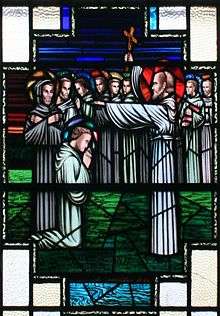
One Roman historian records that the Irish people were divided into "sixteen different nations" or tribes.[47] Traditional histories assert that the Romans never attempted to conquer Ireland, although it may have been considered.[47] The Irish were not, however, cut off from Europe; they frequently raided the Roman territories,[47] and also maintained trade links.[48]
Among the most famous people of ancient Irish history are the High Kings of Ireland, such as Cormac mac Airt and Niall of the Nine Hostages, and the semi-legendary Fianna. The 20th-century writer Seumas MacManus wrote that even if the Fianna and the Fenian Cycle were purely fictional, it would still be representative of the character of the Irish people:
...such beautiful fictions of such beautiful ideals, by themselves presume and prove beautiful-souled people, capable of appreciating lofty ideals.[49]
The introduction of Christianity to the Irish people during the 5th century brought a radical change to the Irish people's foreign relations.[50] The only military raid abroad recorded after that century is a presumed invasion of Wales, which according to a Welsh manuscript may have taken place around the 7th century.[50] In the words of Seumas MacManus:
If we compare the history of Ireland in the 6th century, after Christianity was received, with that of the 4th century, before the coming of Christianity, the wonderful change and contrast is probably more striking than any other such change in any other nation known to history.[50]
Following the conversion of the Irish to Christianity, Irish secular laws and social institutions remained in place.[51]
Migration and invasion in the Middle Ages
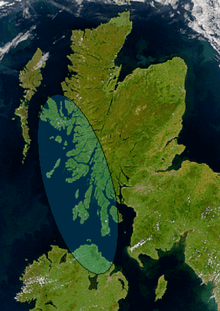
The 'traditional' view is that, in the 4th or 5th century, Goidelic language and Gaelic culture was brought to Scotland by settlers from Ireland, who founded the Gaelic kingdom of Dál Riata on Scotland's west coast.[52][53] This is based mostly on medieval writings from the 9th and 10th centuries. The archaeologist Ewan Campbell argues against this view, saying that there is no archeological or placename evidence for a migration or a takeover by a small group of elites. He states that "the Irish migration hypothesis seems to be a classic case of long-held historical beliefs influencing not only the interpretation of documentary sources themselves, but the subsequent invasion paradigm being accepted uncritically in the related disciplines of archaeology and linguistics."[54] Dál Riata and the territory of the neighbouring Picts merged to form the Kingdom of Alba, and Goidelic language and Gaelic culture became dominant there. The country came to be called Scotland, after the Roman name for the Gaels: Scoti. The Isle of Man and the Manx people also came under massive Gaelic influence in their history.
Irish missionaries such as Saint Columba brought Christianity to Pictish Scotland. The Irishmen of this time were also "aware of the cultural unity of Europe", and it was the 6th-century Irish monk Columbanus who is regarded as "one of the fathers of Europe".[13] Another Irish saint, Aidan of Lindisfarne, has been proposed as a possible patron saint of the United Kingdom,[55] while Saints Kilian and Vergilius became the patron saints of Würzburg in Germany and Salzburg in Austria, respectively. Irish missionaries founded monasteries outside Ireland, such as Iona Abbey, the Abbey of St Gall in Switzerland, and Bobbio Abbey in Italy.
Common to both the monastic and the secular bardic schools were Irish and Latin. With Latin, the early Irish scholars "show almost a like familiarity that they do with their own Gaelic".[56] There is evidence also that Hebrew and Greek were studied, the latter probably being taught at Iona.[57]
"The knowledge of Greek", says Professor Sandys in his History of Classical Scholarship, "which had almost vanished in the west was so widely dispersed in the schools of Ireland that if anyone knew Greek it was assumed he must have come from that country."'[58]
Since the time of Charlemagne, Irish scholars had a considerable presence in the Frankish court, where they were renowned for their learning.[59] The most significant Irish intellectual of the early monastic period was the 9th century Johannes Scotus Eriugena, an outstanding philosopher in terms of originality.[59] He was the earliest of the founders of scholasticism, the dominant school of medieval philosophy.[60] He had considerable familiarity with the Greek language, and translated many works into Latin, affording access to the Cappadocian Fathers and the Greek theological tradition, previously almost unknown in the Latin West.[59]
The influx of Viking raiders and traders in the 9th and 10th centuries resulted in the founding of many of Ireland's most important towns, including Cork, Dublin, Limerick, and Waterford (earlier Gaelic settlements on these sites did not approach the urban nature of the subsequent Norse trading ports). The Vikings left little impact on Ireland other than towns and certain words added to the Irish language, but many Irish taken as slaves inter-married with the Scandinavians, hence forming a close link with the Icelandic people. In the Icelandic Laxdœla saga, for example, "even slaves are highborn, descended from the kings of Ireland."[61] The first name of Njáll Þorgeirsson, the chief protagonist of Njáls saga, is a variation of the Irish name Neil. According to Eirik the Red's Saga, the first European couple to have a child born in North America was descended from the Viking Queen of Dublin, Aud the Deep-minded, and a Gaelic slave brought to Iceland.[14]

The arrival of the Anglo-Normans brought also the Welsh, Flemish, Anglo-Saxons, and Bretons. Most of these were assimilated into Irish culture and polity by the 15th century, with the exception of some of the walled towns and the Pale areas.[51] The Late Middle Ages also saw the settlement of Scottish gallowglass families of mixed Gaelic-Norse and Pict descent, mainly in the north; due to similarities of language and culture they too were assimilated.
Surnames
The Irish were among the first people in Europe to use surnames as we know them today.[62] It is very common for people of Gaelic origin to have the English versions of their surnames beginning with 'Ó' or 'Mac' (Over time however many have been shortened to 'O' or Mc). 'O' comes from the Irish Ó which in turn came from Ua, which means "grandson", or "descendant" of a named person. Mac is the Irish for son.
Names that begin with "O'" include Ó Bánion (O'Banion), Ó Briain (O'Brien), Ó Cheallaigh (O'Kelly), Ó Conchobhair (O'Connor, O'Conor), Ó Chonaill (O'Connell), O'Coiligh (Cox), Ó Cuilinn (Cullen), Ó Domhnaill (O'Donnell), Ó hAnnracháin, (Hanrahan), Ó Máille (O'Malley), Ó Mathghamhna (O'Mahony), Ó Néill (O'Neill), Ó Sé (O'Shea), Ó Súilleabháin (O'Sullivan), Ó Caiside/Ó Casaide (Cassidy),[63] (Brady) Ó Brádaigh/Mac Bradaigh[64] and Ó Tuathail (O'Toole)[65]
Names that begin with Mac or Mc include Mac Cárthaigh (MacCarthy), Mac Diarmada (MacDermott), Mac Domhnaill (MacDonnell), and Mac Mathghamhna (MacMahon) Mag Uidhir (Maguire)), (McDonagh),[66] (MacNamara),[67] (McInerney),[68] (MacGrath),[69] (McEnery),[70] (McGee),[71] (Magennis),[72] (McCann),[73] (McCaffrey),[74] (McLaughlin)[75] and (McNally)[76] Mac is commonly anglicised Mc. However, "Mac" and "Mc" are not mutually exclusive, so, for example, both "MacCarthy" and "McCarthy" are used. both "Mac" and "Ó'" prefixes are both Irish in origin, Anglicized Prefix Mc is far more common in Ireland than Scotland with 2/3 of all Mc Surnames being Irish in origin[77] However,"Mac" is more common in Scotland and Ulster than in the rest of Ireland; furthermore, "Ó" surnames are less common in Scotland having been brought to Scotland from Ireland.[78] The proper surname for a woman in Irish uses the feminine prefix nic (meaning daughter) in place of mac. Thus a boy may be called Mac Domhnaill whereas his sister would be called Nic Dhomhnaill or Ní Dhomhnaill – the insertion of 'h' follows the female prefix in the case of most consonants (bar H, L, N, R, & T).
A son has the same surname as his father. A female's surname replaces Ó with Ní (reduced from Iníon Uí – "daughter of the grandson of") and Mac with Nic (reduced from Iníon Mhic – "daughter of the son of"); in both cases the following name undergoes lenition. However, if the second part of the surname begins with the letter C or G, it is not lenited after Nic. Thus the daughter of a man named Ó Maolagáin has the surname Ní Mhaolagáin and the daughter of a man named Mac Gearailt has the surname Nic Gearailt. When anglicised, the name can remain O' or Mac, regardless of gender.
There are a number of Irish surnames derived from Norse personal names, including Mac Suibhne (Sweeney) from Swein and McAuliffe from "Olaf". The name Cotter, local to County Cork, derives from the Norse personal name Ottir. The name Reynolds is an Anglicization of the Irish Mac Raghnaill, itself originating from the Norse names Randal or Reginald. Though these names were of Viking derivation some of the families who bear them appear to have had Gaelic origins.
"Fitz" is an old Norman French variant of the Old French word fils (variant spellings filz, fiuz, fiz, etc.), used by the Normans, meaning son. The Normans themselves were descendants of Vikings, who had settled in Normandy and thoroughly adopted the French language and culture.[79] With the exception of the Gaelic-Irish Fitzpatrick (Mac Giolla Phádraig) surname, all names that begin with Fitz – including FitzGerald (Mac Gearailt), Fitzsimons (Mac Síomóin/Mac an Ridire) and FitzHenry (Mac Anraí) – are descended from the initial Norman settlers. A small number of Irish families of Goidelic origin came to use a Norman form of their original surname—so that Mac Giolla Phádraig became Fitzpatrick—while some assimilated so well that the Irish name was dropped in favor of a new, Hiberno-Norman form. Another common Irish surname of Norman Irish origin is the 'de' habitational prefix, meaning 'of' and originally signifying prestige and land ownership. Examples include de Búrca (Burke), de Brún, de Barra (Barry), de Stac (Stack), de Tiúit, de Faoite (White), de Londras (Landers), de Paor (Power). The Irish surname "Walsh" (in Irish Breathnach) was routinely given to settlers of Welsh origin, who had come during and after the Norman invasion. The Joyce and Griffin/Griffith (Gruffydd) families are also of Welsh origin.
The Mac Lochlainn, Ó Maol Seachlainn, Ó Maol Seachnaill, Ó Conchobhair, Mac Loughlin and Mac Diarmada families, all distinct, are now all subsumed together as MacLoughlin. The full surname usually indicated which family was in question, something that has been diminished with the loss of prefixes such as Ó and Mac. Different branches of a family with the same surname sometimes used distinguishing epithets, which sometimes became surnames in their own right. Hence the chief of the clan Ó Cearnaigh (Kearney) was referred to as An Sionnach (Fox), which his descendants use to this day. Similar surnames are often found in Scotland for many reasons, such as the use of a common language and mass Irish migration to Scotland in the late 19th and early to mid-20th centuries.
Late Medieval and Tudor Ireland
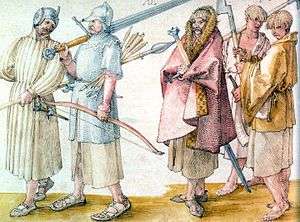
The Irish people of the Late Middle Ages were active as traders on the European continent.[80] They were distinguished from the English (who only used their own language or French) in that they only used Latin abroad—a language "spoken by all educated people throughout Gaeldom".[81] According to the writer Seumas MacManus, the explorer Christopher Columbus visited Ireland to gather information about the lands to the west,[82] a number of Irish names are recorded on Columbus' crew roster preserved in the archives of Madrid and it was an Irishman named Patrick Maguire who was the first to set foot in the Americas in 1492;[82] however, according to Morison and Miss Gould, who made a detailed study of the crew list of 1492, no Irish or English sailors were involved in the voyage.[83]
An English report of 1515 states that the Irish people were divided into over sixty Gaelic lordships and thirty Anglo-Irish lordships.[51] The English term for these lordships was "nation" or "country".[51] The Irish term "oireacht" referred to both the territory and the people ruled by the lord.[51] Literally, it meant an "assembly", where the Brehons would hold their courts upon hills to arbitrate the matters of the lordship.[51] Indeed, the Tudor lawyer John Davies described the Irish people with respect to their laws:
There is no people under the sun that doth love equal and indifferent (impartial) justice better than the Irish, or will rest better satisfied with the execution thereof, although it be against themselves, as they may have the protection and benefit of the law upon which just cause they do desire it.[84]
Another English commentator records that the assemblies were attended by "all the scum of the country"—the labouring population as well as the landowners.[51] While the distinction between "free" and "unfree" elements of the Irish people was unreal in legal terms, it was a social and economic reality.[51] Social mobility was usually downwards, due to social and economic pressures.[51] The ruling clan's "expansion from the top downwards" was constantly displacing commoners and forcing them into the margins of society.[51]
As a clan-based society, genealogy was all important.[51] Ireland 'was justly styled a "Nation of Annalists"'.[85] The various branches of Irish learning—including law, poetry, history and genealogy, and medicine—were associated with hereditary learned families.[86] The poetic families included the Uí Dhálaigh (Daly) and the MacGrath.[51] Irish physicians, such as the O'Briens in Munster or the MacCailim Mor in the Western Isles, were renowned in the courts of England, Spain, Portugal and the Low Countries.[84] Learning was not exclusive to the hereditary learned families, however; one such example is Cathal Mac Manus, the 15th century diocesan priest who wrote the Annals of Ulster.[86] Other learned families included the Mic Aodhagáin and Clann Fhir Bhisigh.[86] It was this latter family which produced Dubhaltach Mac Fhirbhisigh, the 17th century genealogist and compiler of the Leabhar na nGenealach. (see also Irish medical families).
Plantations
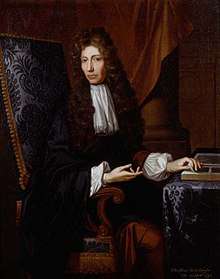
After Ireland was subdued by England, the English—under James I of England (r. 1603–1625), the Lord Protector Oliver Cromwell (1653–1658), William III of England (r. 1689–1702) and their British successors—began the settling of Protestant Scottish and English colonists into Ireland, where they settled most heavily in the northern province of Ulster. The Plantations of Ireland, and in particular the Plantation of Ulster in the 17th century, introduced great numbers of Scottish, English as well as French Huguenots as colonists.
Many Gaelic Irish were displaced during the 17th century plantations. Only in the major part of Ulster did the plantations of mostly Scottish prove long-lived; the other three provinces (Connacht, Leinster, and Munster) remained heavily Gaelic Irish. Eventually, the Anglo-Irish and Protestant populations of those three provinces decreased drastically as a result of the political developments in the early 20th century in Ireland, as well as the Catholic Church's Ne Temere decree for mixed marriages, which obliged the non-Catholic partner to have the children raised as Catholics.
Enlightenment Ireland
There have been notable Irish scientists. The Anglo-Irish scientist Robert Boyle (1627–1691) is considered the father of chemistry for his book The Sceptical Chymist, written in 1661.[87] Boyle was an atomist, and is best known for Boyle's Law. The hydrographer Rear Admiral Francis Beaufort (1774–1857), an Irish naval officer of Huguenot descent, was the creator of the Beaufort scale for indicating wind force. George Boole (1815–1864), the mathematician who invented Boolean algebra, spent the latter part of his life in Cork. The 19th century physicist George Stoney introduced the idea and the name of the electron. He was the uncle of another notable physicist, George FitzGerald.
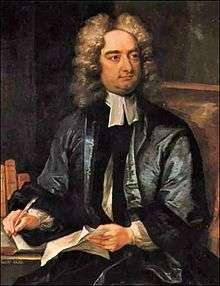
The Irish bardic system, along with the Gaelic culture and learned classes, were upset by the plantations, and went into decline. Among the last of the true bardic poets were Brian Mac Giolla Phádraig (c. 1580–1652) and Dáibhí Ó Bruadair (1625–1698). The Irish poets of the late 17th and 18th centuries moved toward more modern dialects. Among the most prominent of this period were Séamas Dall Mac Cuarta, Peadar Ó Doirnín, Art Mac Cumhaigh, Cathal Buí Mac Giolla Ghunna, and Seán Clárach Mac Domhnaill. Irish Catholics continued to receive an education in secret "hedgeschools", in spite of the Penal laws.[88] A knowledge of Latin was common among the poor Irish mountaineers in the 17th century, who spoke it on special occasions, while cattle were bought and sold in Greek in the mountain market-places of Kerry.[89]
For a comparatively small population of about 6 million people, Ireland made an enormous contribution to literature. Irish literature encompasses the Irish and English languages. Notable Irish writers, playwrights and poets include Jonathan Swift, Laurence Sterne, Oscar Wilde, Oliver Goldsmith, James Joyce, George Bernard Shaw, Samuel Beckett, Bram Stoker, W.B Yeats, Séamus Heaney and Brendan Behan.
19th century
The Great Famine / An Górta Mór
Known as An Górta Mór (The great hunger) in Gaeilge, millions of Irish people died and emigrated during Ireland's largest famine. The famine lasted from 1845 - 1849, it was worst during 1847 which was known as Black '47. The famine occurred due to the extremely impoverished Irish population's staple food the potato being infected with Blight, and English forces appropriating all other crops and livestock to feed her armies abroad.[90] This meant the crop failed and turned black. Starving people who tried to eat them would only vomit it back up soon afterwards. Soup kitchens were set up but made little difference. The English government produced little aid, only sending raw corn known as 'Peel's Brimstone' to Ireland. It was known by this name after the British PM at the time and the fact that native Irish weren't aware on how to cook corn. This led to little or no improvement. The British government set up workhouses which were disease ridden (with cholera, TB and others) but they also failed as little food was available and many died on arrival as they were overworked. Some English political figures at the time saw the famine as a purge from God to exterminate the majority of the native Irish population.
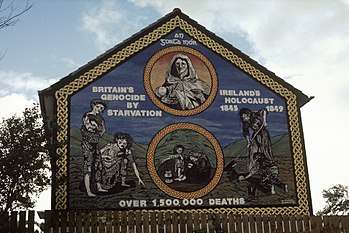
Irish people emigrated to escape the famine journeying predominantly to the east coast of the US especially Boston and New York, Liverpool in England, Australia, Canada and New Zealand. Many records show the majority of emigrants to Australia were in fact prisoners sent to assist in the construction of English colonies there. A substantial proportion of these committed crimes in hopes of being extradited to Australia, favouring it to the persecution and hardships they endured in their homeland. Emigrants travelled on 'Coffin Ships' they were called this as there were high mortality rates on board. Many died of disease or starved. Conditions on board were abysmal - tickets were expensive so stowaways were common, little food stuff was given to passengers who were simply viewed as cargo in the eyes of the ship workers. Famous coffin ships include the Jeanie Johnston and the Dunbrody.
There are many statues and memorials in Dublin, New York and other cities in memory of the famine. The fields of Athenry is a famous song about the great famine and is often sung at national team sporting events in memory and homage to those affected by the famine.
The Great famine is one of the biggest events in Irish history and is ingrained in the identity on the nation to this day. It was a major in factor in Irish Nationalism and Ireland's fight for Independence during subsequent rebellions, as many Irish people felt a stronger need to regain Independence from English rule.
20th century
After the Irish War of Independence (1919–1921) the Anglo-Irish Treaty was signed which led to the formation of the semi-independent Irish Free State (now the independent Republic of Ireland) which consisted of 26 counties in the south and Donegal in the North-West. The remaining six counties in the northeast remained in the United Kingdom as Northern Ireland. It is predominately religion, historical, and political differences that divide the two communities of (nationalism and unionism). Four polls taken between 1989 and 1994 revealed that when asked to state their national identity, over 79% of Northern Irish Protestants replied "British" or "Ulster" with 3% or less replying "Irish", while over 60% of Northern Irish Catholics replied "Irish" with 13% or less replying "British" or "Ulster".[91] A survey in 1999 showed that 72% of Northern Irish Protestants considered themselves "British" and 2% "Irish", with 68% of Northern Irish Catholics considering themselves "Irish" and 9% "British".[92] The survey also revealed that 78% of Protestants and 48% of all respondents felt "Strongly British", while 77% of Catholics and 35% of all respondents felt "Strongly Irish". 51% of Protestants and 33% of all respondents felt "Not at all Irish", while 62% of Catholics and 28% of all respondents felt "Not at all British".[93][94]
Recent history
Religions in Ireland
.jpg)
In the Republic of Ireland, as of 2016, 3.7 million people or about 78.3% of the population are Roman Catholic.[95] In Northern Ireland about 41.6% of the population are Protestant (19.1% Presbyterian, 13.7% Church of Ireland, 3.0% Methodist, 5.8% Other Christian) whilst approximately 40.8% are Catholic as of 2011.
The 31st International Eucharistic Congress was held in Dublin in 1932, that year being the supposed 1,500th anniversary of Saint Patrick's arrival. Ireland was then home to 3,171,697 Catholics, about a third of whom attended the Congress.[96][97] It was noted in Time Magazine that the Congress' special theme would be "the Faith of the Irish".[96] The massive crowds were repeated at Pope John Paul II's Mass in Phoenix Park in 1979.[98] The idea of faith has affected the question of Irish identity even in relatively recent times, apparently more so for Catholics and Irish-Americans. Today the majority of Irish people in the Republic of Ireland identify as Catholic, although church attendance have significantly dropped in recent decades. In Northern Ireland, where almost 50% of the population is Protestant, there has also been a decline in attendances.
What defines an Irishman? His faith, his place of birth? What of the Irish-Americans? Are they Irish? Who is more Irish, a Catholic Irishman such as James Joyce who is trying to escape from his Catholicism and from his Irishness, or a Protestant Irishman like Oscar Wilde who is eventually becoming Catholic? Who is more Irish... someone like C.S. Lewis, an Ulster Protestant, who is walking towards it, even though he never ultimately crosses the threshold?[99]
This has been a matter of concern over the last century for the followers of nationalist ideologists such as DP Moran.
Irish identity
_In_Dublin_Was_Excellent_But_The_Weather_And_The_Turnout_Was_Disappointing_(8566201364).jpg)
Thomas Davis, a prominent Protestant Irish nationalist who founded the Young Ireland movement, identified the Irish as a Celtic nation.[100] He estimated that ethnically, 5/6ths of the nation were either of Gaelic Irish-origin, descended from returned Scottish Gaels (including much of the Ulster Scots) and some Celtic Welsh (such as his own ancestors and those carrying surnames such as Walsh and Griffiths).[100] As part of this he was a staunch supporter of the Irish language as the "national language".[100] In regards to the Germanic minority in Ireland (of Norman and Anglo-Saxon origin) he believed that they could be assimilated into Irishness if they had a "willingness to be part of the Irish Nation".[101]
Europe
The Republic of Ireland and the United Kingdom joined the European Community in 1973, and Irish citizens became additionally Citizens of the European Union with the Maastricht Treaty signed in 1992. This brought a further question for the future of Irish identity; whether Ireland was "closer to Boston than to Berlin:"
History and geography have placed Ireland in a very special location between America and Europe... As Irish people our relationships with the United States and the European Union are complex. Geographically we are closer to Berlin than Boston. Spiritually we are probably a lot closer to Boston than Berlin. – Mary Harney, Tánaiste, 2000[102]
Irish diaspora
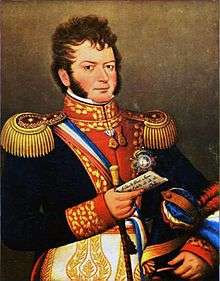
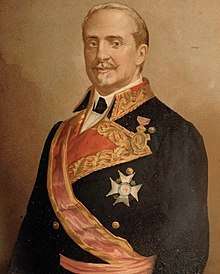
The Irish diaspora consists of Irish emigrants and their descendants in countries such as the United States, Great Britain, Canada, Australia, New Zealand, South Africa, and nations of the Caribbean such as Jamaica and Barbados. These countries all have large minorities of Irish descent, who in addition form the core of the Catholic Church in those countries.
Many famous and influential figures have claimed Irish ancestry such as Che Guevara, Walt Disney, Barack Obama, JFK, Muhammad Ali and Maréchal The 1st Duke of Magenta, the second President of the Third Republic.
Many Irish people were also transported to the island of Montserrat, to work as indentured servants, exiled prisoners or slaves. Unlike African chattel slaves, the majority of Irish labourers who were sent to Montserrat did so by personal choice although they were tricked into doing so by the promise of payment and land of which they did not receive.[103] Some were exiled by the English Oliver Cromwell due to the large Irish population and their attempted rebellion on 17 March 1768. To this day, the Island celebrates St. Patrick's Day as a public holiday to commemorate the event.[104] People of Irish descent also feature strongly in Latin America, especially in Argentina and important minorities in Brazil, Chile, and Mexico. In 1995, President Mary Robinson reached out to the "70 million people worldwide who can claim Irish descent".[105] Today the diaspora is believed to contain an estimated 80 million people.[106]
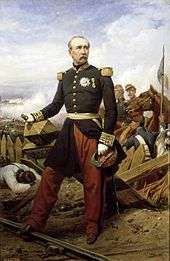
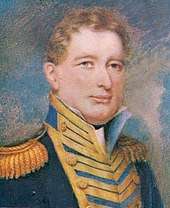
There are also large Irish communities in some mainland European countries, notably in Spain, France and Germany. Between 1585 and 1818, over half a million Irish departed Ireland to serve in the wars on the Continent, in a constant emigration romantically styled the "Flight of the Wild Geese" and, before that, in the 'Flight of the Earls', just before the Plantation of Ulster.[107] In the early years of the English Civil War, a French traveller remarked that the Irish "are better soldiers abroad than at home".[108] Later, Irish brigades in France and Spain fought in the Wars of the Spanish and Austrian Succession and the Napoleonic Wars.[107] In the words of Field Marshal The 1st Duke of Wellington, the Irish-born 'Iron Duke', a notable representative of the Irish military diaspora, "Ireland was an inexhaustible nursery for the finest soldiers".[109]
The British Legions were units that fought under Simón Bolívar against Spain for the independence of Colombia, Venezuela, Ecuador, and Peru. Venezuelans called them the Albion Legion. They were composed of over seven thousand volunteers, mainly Napoleonic War veterans from Great Britain and Ireland. Volunteers in the British Legion were motivated by a combination of both genuine political and mercenary motives.[110] The most famous cause of emigration was the Great Famine of the late 1840s. A million are thought to have emigrated to Liverpool as a result of the famine.[111] For both the Irish in Ireland and those in the resulting diaspora, the famine entered folk memory[112] and became a rallying point for various nationalist movements.
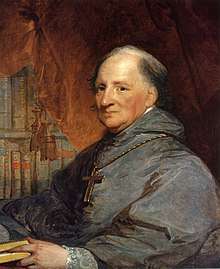
People of Irish descent are the second largest self-reported ethnic group in the United States, after German Americans. Nine of the signatories of the American Declaration of Independence were of Irish origin.[113] Among them was the sole Catholic signatory, Charles Carroll of Carrollton, whose family were the descendants of Ely O'Carroll, an Irish prince who had suffered under Cromwell.[114] At least twenty-five presidents of the United States have some Irish ancestral origins, including George Washington.[115][116][117][118] Since John F. Kennedy took office in 1961, every American President (with the exception of Gerald Ford and Donald Trump) has had some Irish blood.[119][120][121] An Irish-American, James Hoban, was the designer of the White House. Commodore John Barry, who was born in County Wexford, was the "father of the United States Navy".[122]
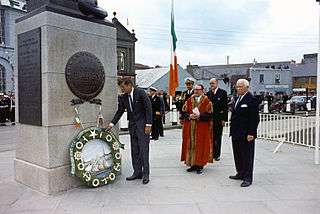
In the mid-19th century, large numbers of Irish immigrants were conscripted into Irish regiments of the United States Army at the time of the Mexican–American War. The vast majority of the 4,811 Irish-born soldiers served in the U.S. Army, but some defected to the Mexican Army, primarily to escape mistreatment by Anglo-Protestant officers and the strong anti-Catholic discrimination in America.[123] These were the San Patricios, or Saint Patrick's Battalion—a group of Irish led by Galway-born John O'Riley, with some German, Scottish and American Catholics.[123] They fought until their surrender at the decisive Battle of Churubusco, and were executed outside Mexico City by the American government on 13 September 1847.[123] The battalion is commemorated in Mexico each year on 12 September.[124]
During the 18th and 19th centuries, 300,000 free emigrants and 45,000 convicts left Ireland to settle in Australia.[125] Today, Australians of Irish descent are one of the largest self-reported ethnic groups in Australia, after English and Australian. In the 2006 Census, 1,803,741 residents identified themselves as having Irish ancestry either alone or in combination with another ancestry.[126] However this figure does not include Australians with an Irish background who chose to nominate themselves as 'Australian' or other ancestries. The Australian embassy in Dublin states that up to thirty percent of the population claim some degree of Irish ancestry.[127]
It is believed that as many as 30,000 Irish people emigrated to Argentina between the 1830s and the 1890s.[9] This was encouraged by the clergy, as they considered a Catholic country, Argentina, preferable to a more Protestant United States. This flow of emigrants dropped sharply when assisted passage to Australia was introduced at which point the Argentine government responded with their own scheme and wrote to Irish bishops, seeking their support. However, there was little or no planning for the arrival of a large number of immigrants, no housing, no food.[128] Many died, others made their way to the United States and other destinations, some returned to Ireland, a few remained and prospered. Thomas Croke Archbishop of Cashel, said: "I most solemnly conjure my poorer countrymen, as they value their happiness hereafter, never to set foot on the Argentine Republic however tempted to do so they may be by offers of a passage or an assurance of comfortable homes."[129] Some famous Argentines of Irish descent include Che Guevara, former president Edelmiro Julián Farrell, and admiral William Brown.
There are people of Irish descent all over South America, such as the Chilean liberator Bernardo O'Higgins and the Peruvian photographer Mario Testino. Although some Irish retained their surnames intact, others were assimilated into the Spanish vernacular. The last name O'Brien, for example, became Obregón.
People of Irish descent are also one of the largest self-reported ethnic groups in Canada, after English, French and Scottish Canadians. As of 2006, Irish Canadians number around 4,354,155.[7]
See also
- Ethnic groups in Europe
- List of Americans of Irish descent
- List of expatriate Irish populations
- List of Ireland-related topics
- List of Irish people
- Tanistry
- The Ireland Funds
- Norse–Gaels
- Hiberno-Normans
- Anglo Irish
- Ulster-Scots dialects
- Ulster-Scots people
- Irish Travellers
Citations
- ceu@scotland.gsi.gov.uk, Scottish Government, St. Andrew's House, Regent Road, Edinburgh EH1 3DG Tel:0131 556 8400 (29 May 2009). "The Scottish Diaspora and Diaspora Strategy: Insights and Lessons from Ireland". www.scotland.gov.uk.
- Ethnic Irish at Ethnologue (22nd ed., 2020)
- Demography of Northern Ireland
- American FactFinder, United States Census Bureau. "U.S. Census Bureau, 2007". Factfinder.census.gov. Archived from the original on 10 April 2010. Retrieved 30 May 2010.
- Maybin, Simon (2 September 2016). "How many Britons are entitled to an Irish passport?" – via www.bbc.co.uk.
- "Department of Foreign Affairs - Emigrant Grants". 28 July 2013. Archived from the original on 28 July 2013.CS1 maint: BOT: original-url status unknown (link)
- "Ethnic Origin (264), Single and Multiple Ethnic Origin Responses (3), Generation Status (4), Age Groups (10) and Sex (3) for the Population in Private Households of Canada, Provinces, Territories, Census Metropolitan Areas and Census Agglomerations, 2011 National Household Survey". Statistics Canada. 2011.
- "The Irish in New Zealand: Historical Contexts and Perspectives - Brian Easton". www.eastonbh.ac.nz.
- "Flying the Irish flag in Argentina". Western People. 14 March 2008. Archived from the original on 14 October 2007. Retrieved 4 July 2008.
- O'Higgins Tours. "Los irlandeses en Chile". Retrieved 10 January 2010.
- "Présentation de l'Irlande". France Diplomatie : : Ministère de l'Europe et des Affaires étrangères.
- Helgason, Agnar; et al. (2000). "Estimating Scandinavian and Gaelic ancestry in the male settlers of Iceland". The American Journal of Human Genetics. 67 (3): 697–717. doi:10.1086/303046. PMC 1287529. PMID 10931763.
- "Pope Calls Irish Monk a Father of Europe". Zenit. 11 July 2007. Archived from the original on 15 June 2008. Retrieved 15 July 2007.
- Smiley, p. 630
- "Dáil Éireann – 29/Apr/1987 Ceisteanna—Questions. Oral Answers. – Australian Bicentenary". Oireachtasdebates.oireachtas.ie. 29 April 1987. Retrieved 1 March 2014.
- Ann C. Humphrey. "They Accuse Us of Being Descended from Slaves". Settlement History, Cultural Syncretism, and the Foundation of Medieval Icelandic Identity. Rutgers University, 2009.
- "Pytheas | Greek explorer". Encyclopedia Britannica.
- Thomas, Charles (1997). Celtic Britain. London: Thames and Hudson. p. 82.
If we seek a meaning, the favoured view is that it arises from an older word implying 'people of the forms, shapes or depictions' (*kwrt-en-o-).
- Allen, Stephen (2007). Lords of Battle: The World of the Celtic Warrior. Oxford: Osprey Publishing. p. 174.
Pretani is generally believed to mean "painted" or rather "tatooed", likely referring to the use by the Britons of the blue dye extracted from woad. ... it is more likely to be a nickname given them by outsiders ... It may be compared with the word Picti ... which was used by the Romans in the 3rd century AD.
- Siculi, Diodori; L. Rhodoman; G. Heyn; N. Eyring (1798). "Book V, Sections 21–22". In Peter Wesseling (ed.). Bibliothecae Historicae Libri Qui Supersunt: Nova Editio (in Ancient Greek and Latin). Argentorati: Societas Bipontina. pp. 292–297. The section numeration differs somewhat in different translations; the material is to be found near the end of Book V.
- Chisholm, Hugh, ed. (1911). . Encyclopædia Britannica. 9 (11th ed.). Cambridge University Press. p. 744.
- Mac Manus, p 1 & 7
- MacManus, p 1
- McEvoy, B; Richards, M; Forster, P; Bradley, DG (October 2004). "Brian McEvoy, et al., "The Longue Durée of Genetic Ancestry: Multiple Genetic Marker Systems and Celtic Origins on the Atlantic Facade of Europe". American Journal of Human Genetics. 75 (4): 693–702. doi:10.1086/424697. PMC 1182057. PMID 15309688.
- Stephen Oppenheimer, The Origins of the British – A Genetic Detective Story, 2006, Constable and Robinson, ISBN 1-84529-158-1
- Sykes, Bryan (2006). Blood of the Isles: Exploring the Genetic Roots of Our Tribal History. Bantam. ISBN 978-0-593-05652-3.
- "ISOGG 2009". Isogg.org. Retrieved 28 March 2010.
- Bramanti, B.; Thomas, M. G.; Haak, W.; Unterlaender, M.; Jores, P.; Tambets, K.; Antanaitis-Jacobs, I.; Haidle, M. N.; Jankauskas, R.; Kind, C.-J.; Lueth, F.; Terberger, T.; Hiller, J.; Matsumura, S.; Forster, P.; Burger, J. (2009). "Genetic Discontinuity Between Local Hunter-Gatherers and Central Europes First Farmers". Science. 326 (5949): 137–140. Bibcode:2009Sci...326..137B. doi:10.1126/science.1176869. PMID 19729620.
- Malmström, Helena; Gilbert, M. Thomas P.; Thomas, Mark G.; Brandström, Mikael; Storå, Jan; Molnar, Petra; Andersen, Pernille K.; Bendixen, Christian; Holmlund, Gunilla; Götherström, Anders; Willerslev, Eske (2009). "Ancient DNA Reveals Lack of Continuity between Neolithic Hunter-Gatherers and Contemporary Scandinavians". Current Biology. 19 (20): 1758–1762. doi:10.1016/j.cub.2009.09.017. PMID 19781941. Retrieved 28 March 2010.
- Alonso, Santos; et al. (2005). "The Place of the Basques in the European Y-chromosome Diversity Landscape". European Journal of Human Genetics. 13 (12): 1293–1302. doi:10.1038/sj.ejhg.5201482. PMID 16094307.
- B. Arredi, E. S. Poloni and C. Tyler-Smith (2007). "The peopling of Europe". In Crawford, Michael H. (ed.). Anthropological genetics: theory, methods and applications. Cambridge, UK: Cambridge University Press. p. 394. ISBN 978-0-521-54697-3.
- Balaresque; et al. (2010). Penny, David (ed.). "A Predominantly Neolithic Origin for European Paternal Lineages". PLOS Biology. 8 (1): 119–122. doi:10.1371/journal.pbio.1000285. PMC 2799514. PMID 20087410.
- Haak, Wolfgang; Lazaridis, Iosif; Patterson, Nick; Rohland, Nadin; Mallick, Swapan; Llamas, Bastien; Brandt, Guido; Nordenfelt, Susanne; Harney, Eadaoin; Stewardson, Kristin; Fu, Qiaomei; Mittnik, Alissa; Bánffy, Eszter; Economou, Christos; Francken, Michael; Friederich, Susanne; Pena, Rafael Garrido; Hallgren, Fredrik; Khartanovich, Valery; Khokhlov, Aleksandr; Kunst, Michael; Kuznetsov, Pavel; Meller, Harald; Mochalov, Oleg; Moiseyev, Vayacheslav; Nicklisch, Nicole; Pichler, Sandra L.; Risch, Roberto; Rojo Guerra, Manuel A.; et al. (2015). "Massive migration from the steppe is a source for Indo-European languages in Europe". Nature. 522 (7555): 013433. arXiv:1502.02783. Bibcode:2015Natur.522..207H. bioRxiv 10.1101/013433. doi:10.1038/NATURE14317. PMC 5048219. PMID 25731166.
- Allentoft, Morten E.; Sikora, Martin; Sjögren, Karl-Göran; Rasmussen, Simon; Rasmussen, Morten; Stenderup, Jesper; Damgaard, Peter B.; Schroeder, Hannes; Ahlström, Torbjörn; Vinner, Lasse; Malaspinas, Anna-Sapfo; Margaryan, Ashot; Higham, Tom; Chivall, David; Lynnerup, Niels; Harvig, Lise; Baron, Justyna; Casa, Philippe Della; Dąbrowski, Paweł; Duffy, Paul R.; Ebel, Alexander V.; Epimakhov, Andrey; Frei, Karin; Furmanek, Mirosław; Gralak, Tomasz; Gromov, Andrey; Gronkiewicz, Stanisław; Grupe, Gisela; Hajdu, Tamás; et al. (2015). "Population genomics of Bronze Age Eurasia". Nature. 522 (7555): 167–172. Bibcode:2015Natur.522..167A. doi:10.1038/nature14507. PMID 26062507.
- Mathieson, Iain; Lazaridis, Iosif; Rohland, Nadin; Mallick, Swapan; Patterson, Nick; Alpaslan Roodenberg, Songul; Harney, Eadaoin; Stewardson, Kristin; Fernandes, Daniel; Novak, Mario; Sirak, Kendra; Gamba, Cristina; Jones, Eppie R.; Llamas, Bastien; Dryomov, Stanislav; Pickrell, Joseph; Arsuaga, Juan Luis; De Castro, Jose Maria Bermudez; Carbonell, Eudald; Gerritsen, Fokke; Khokhlov, Aleksandr; Kuznetsov, Pavel; Lozano, Marina; Meller, Harald; Mochalov, Oleg; Moiseyev, Vayacheslav; Rojo Guerra, Manuel A.; Roodenberg, Jacob; Verges, Josep Maria; et al. (2015). "Eight thousand years of natural selection in Europe". bioRxiv: 016477. doi:10.1101/016477.
- Radford, Tim (28 December 2015). "Irish DNA originated in Middle East and eastern Europe". The Guardian.
- Lara M. Cassidy; Rui Martiniano; et al. (28 December 2015). "Neolithic and Bronze Age migration to Ireland and establishment of the insular Atlantic genome" (PDF). PNAS. doi:10.1073/pnas.1518445113.
- Gilbert, Edmund; O’Reilly, Seamus; Merrigan, Michael; McGettigan, Darren; Molloy, Anne M.; Brody, Lawrence C.; Bodmer, Walter; Hutnik, Katarzyna; Ennis, Sean; Lawson, Daniel J.; Wilson, James F.; Cavalleri, Gianpiero L. (8 December 2017). "The Irish DNA Atlas: Revealing Fine-Scale Population Structure and History within Ireland". Scientific Reports. 7 (1): 17199. Bibcode:2017NatSR...717199G. doi:10.1038/s41598-017-17124-4. PMC 5722868. PMID 29222464.
- "Celtic Population Structure" (PDF). biorxiv.org.
- Who were the Black Irish? What is the origin of the Irish with swarthy dark features? A subject of historical discussion, the subject is almost never referred to in Ireland. IrishCentral.com. Staff Writers, 26-03-2013. Retrieved 06-08-2013.
- Rees, J.L. (1999). "Pigmentation, melanocortins and red hair. 'Do freckles and red hair help Irishmen catch leprechauns?'". Quarterly Journal of Medicine. 92 (3): 125–131. doi:10.1093/qjmed/92.3.125. PMID 10326071.
- thomas p. kunesh, 1981. "The myth of the Black Irish: Spanish syntagonism and prethetical salvation." Published online at: www.darkfiber.com/blackirish/. Retrieved 05-25-2013.
- Bob Quinn (2005). The Atlantean Irish: Ireland's oriental and maritime heritage. The Lilliput Press.
- "Archived copy". Archived from the original on 13 February 2012. Retrieved 20 March 2012.CS1 maint: archived copy as title (link)
- "Montserrat Article". freepages.rootsweb.com.
- "The Black Irish". RTÉ Archives.
- MacManus, p 86
- MacManus, p 87
- MacManus, p67
- MacManus, p 89
- Nicholls
- Jones, Charles (1997). The Edinburgh history of the Scots language. Edinburgh University Press. p. 551. ISBN 978-0-7486-0754-9.
- Nora Kershaw Chadwick, Myles Dyllon (1972). The Celtic Realms. Weidenfeld & Nicolson. p. 66. ISBN 978-0-7607-4284-6.
- Campbell, Ewan. "Were the Scots Irish?" in Antiquity #75 (2001).
- "Home-grown holy man: Cry God for Harry, Britain and... St Aidan". The Independent. London. 23 April 2008. Retrieved 21 July 2008.
- MacManus, p 221
- MacManus, p 221-222
- MacManus, p 215
- "John Scottus Eriugena". Stanford Encyclopedia of Philosophy. Stanford University. 17 October 2004. Retrieved 21 July 2008.
- Toman, p 10: "Abelard himself was... together with John Scotus Erigena (9th century), and Lanfranc and Anselm of Canterbury (both 11th century), one of the founders of scholasticism."
- Smiley, p. 274
- Woulfe, Patrick (1923). Sloinnte Gaedheal is Gall: Irish names and surnames. M. H. Gill & son. pp. xx. Retrieved 20 February 2010.
- "Cassidy Name Meaning, Family History, Family Crest & Coats of Arms". HouseOfNames.
- "Brady Name Meaning, Family History, Family Crest & Coats of Arms". HouseOfNames.
- "Cox family pedigree". www.libraryireland.com.
- "McDonagh Name Meaning, Family History, Family Crest & Coats of Arms". HouseOfNames.
- "McNamara Name Meaning, Family History, Family Crest & Coats of Arms". HouseOfNames.
- "McInerney Name Meaning, Family History, Family Crest & Coats of Arms". HouseOfNames.
- "McGrath Name Meaning, Family History, Family Crest & Coats of Arms". HouseOfNames.
- "McEnery Name Meaning, Family History, Family Crest & Coats of Arms". HouseOfNames.
- "McGee Name Meaning, Family History, Family Crest & Coats of Arms". HouseOfNames.
- "McGuinness Name Meaning, Family History, Family Crest & Coats of Arms". HouseOfNames.
- "Mccann Name Meaning & Mccann Family History at Ancestry.com®". www.ancestry.com.
- "Mccaffrey Name Meaning & Mccaffrey Family History at Ancestry.com®". www.ancestry.com.
- "McLaughlin Name Meaning, Family History, Family Crest & Coats of Arms". HouseOfNames.
- "Surname Database: McNally Last Name Origin". The Internet Surname Database.
- Burdess, Neil. "A dozen things you might not know about Irish names". The Irish Times.
- "ScottishHistory.com". www.scottishhistory.com.
- Richard Hooker. "The Normans". Washington State University. Archived from the original on 14 June 2008. Retrieved 12 July 2008.
- MacManus, p 343
- MacManus, p 340
- MacManus, p 343–344
- Taviani, Paolo Emilio (1985). Christopher Columbus. p. 376. ISBN 978-0-85613-922-2.
- MacManus, p 348
- MacManus, p 352
- Jefferies, Dr. Henry A. "Culture and Religion in Tudor Ireland, 1494–1558". University College Cork. Archived from the original on 16 April 2008. Retrieved 23 June 2008.
- Boyle on Atheism by J.J. MacIntosh (University of Toronto Press ISBN 978-0-8020-9018-8), page 6
- MacManus, p 461
- MacManus, p 461-462
- David R. Montgomery (14 May 2007). Dirt: The Erosion of Civilizations. University of California Press. ISBN 978-0-520-93316-3.
- "in, Social Attitudes in Northern Ireland: The Fifth Report". Cain.ulst.ac.uk. Retrieved 28 March 2010.
- "Northern Ireland Life and Times Survey". Ark.ac.uk. 9 May 2003. Retrieved 28 March 2010.
- "Northern Ireland Life and Times Survey". Ark.ac.uk. 12 May 2003. Retrieved 28 March 2010.
- "Northern Ireland Life and Times Survey". Ark.ac.uk. 9 May 2003. Retrieved 28 March 2010.
- Smyth, Declan (12 October 2017). "Profile 8 – Irish Travellers Ethnicity and Religion" (Press release). CSO.ie. Central Statistics Office. Retrieved 5 January 2018.
- "In Dublin". Time Magazine. 20 June 1932. Retrieved 23 June 2008.
- John Paul McCarthy; Tomás O'Riordan. "The 31st International Eucharistic Congress, Dublin, 1932". University College Cork. Archived from the original on 16 April 2008. Retrieved 23 June 2008.
Newspapers and contemporaries estimated that close to a million souls had converged on the Phoenix Park for the climax of the Congress
- The figure 1,250,000 is mentioned on the commemorative stone at the Papal Cross in the Phoenix Park, Dublin; a quarter of the population of the island of Ireland, or a third of the population of Republic of Ireland
- Pearce, Joseph (March–April 2007). "Editorial: The Celtic Enigma". St. Austin Review. Ave Maria University, Naples, Florida: Sapientia Press. 7 (2): 1.
- Thomas Davis (28 February 2013). "Our National Language". From-Ireland.net. Retrieved 18 October 2016.
- Thomas Davis – Dame Street (17 March 2012). "90,000 Photographs By William Murphy – 90,000 Photographs By William Murphy". Dublinstreets.osx128.com. Archived from the original on 27 March 2014. Retrieved 1 March 2014.
- Aldous, p 185
- "The Irish in the Anglo-Caribbean: servants or slaves? - History Ireland". 29 February 2016.
- Fergus, Howard A (1996). Gallery Montserrat: some prominent people in our history. Canoe Press University of West Indies. p. 83. ISBN 978-976-8125-25-5.
- "Ireland's Diaspora". Irelandroots.com. Retrieved 28 March 2010.
- The island history, discoverireland.com
- "The Wild Geese, Men-at-Arms 102". Osprey Publishing. Archived from the original on 8 December 2008.
- McLaughlin, p4
- Davies, p 832
- Brown, Matthew (2006). Adventuring through Spanish Colonies: Simón Bolívar, Foreign Mercenaries and the Birth of New Nations. Liverpool University Press. p. 210. ISBN 9781846310447.
- David Ross, Ireland: History of a Nation, New Lanark: Geddes & Grosset, 2002, p. 226. ISBN 1-84205-164-4
- The Famine that affected Ireland from 1845 to 1852 has become an integral part of folk legend. Kenealy, This Great Calamity, p. 342.
- "Irish-American History Month, 1995". irishamericanheritage.com. Archived from the original on 9 May 2008. Retrieved 25 June 2008.
- Maryland Traces Its Irish Roots, Maryland Office of Tourism
- "Presidents of the United States with "Irish Roots"". irishamericanheritage.com. Archived from the original on 29 September 2008. Retrieved 25 June 2008.
- Marck, John T. "William H. Taft". aboutfamouspeople.com. Retrieved 25 June 2008.
- "Warren Gamaliel Harding". thinkquest.com. Retrieved 25 June 2008.
- Marck, John T. "Harry S. Truman". aboutfamouspeople.com. Retrieved 25 June 2008.
- "American Presidents with Irish Ancestors". Directory of Irish Genealogy. Retrieved 25 June 2008.
- "The Man Who Made Trump Who He Is". Politico. Retrieved 24 January 2017.
- "Donald Trump's Scottish roots: How a tiny island could shape a President". CNN. Retrieved 24 January 2017.
- John Barry Kelly. "Commodore Barry". Archived from the original on 5 August 2013. Retrieved 25 June 2007.
- Michael G. Connaughton (September 2005). "Beneath an Emerald Green Flag, The Story of Irish Soldiers in Mexico". The Society for Irish Latin American Studies. Retrieved 12 July 2008.
- Mark R. Day. "The San Patricios: Mexico's Fighting Irish". Archived from the original on 3 March 2000. Retrieved 12 July 2008.
- Ryan, Sean (2006). "Botany Bay 1791–1867". Wild Geese Heritage Museum and Library Portumna, Co. Galway. Retrieved 27 May 2009.
- Australian Bureau of Statistics (25 October 2007). "Australia". 2006 Census QuickStats. Retrieved 25 July 2007.
- "Australia- Ireland relationship – Australian Embassy". Ireland.embassy.gov.au. Retrieved 28 March 2010.
- Cole, Patrick (29 March 1889). "Irish Emigrants to the Argentine Republic". Western Daily Press. Retrieved 29 November 2015 – via British Newspaper Archive.
It is a sad and pitiable sight to see Irish mothers with, in some cases, their dying babes in their arms ... ... in many cases mothers sold their clothing from their backs to procure food for their starving children
- "The Irish in Argentina". Wander Argentina. Retrieved 29 November 2015.
References
- Aldous, Richard (2007). Great Irish Speeches. London: Quercus Publishing PLC. ISBN 978-1-84724-195-5.
- Davies, Norman (1996). Europe: A History. Oxford: Oxford University Press. ISBN 978-0-19-820171-7.
- Ellis, Steven G. (1985). Tudor Ireland: Crown, Community, and the Conflict of Cultures, 1470–1603. Great Britain: Longman. ISBN 978-0-582-49341-4.
- Irish Names at Library Ireland
- MacManus, Seamus (1921). The Story of the Irish Race: A Popular History of Ireland. Ireland: The Irish Publishing Co. ISBN 978-0-517-06408-5. Retrieved 17 March 2013.
- McLaughlin, Mark G. (1980). The Wild Geese: The Irish Brigades of France and Spain. Christopher Warner, illustrator. Osprey Publishing. ISBN 978-0-85045-358-4.
- Nicholls, Kenneth W. (1972). Gaelic and Gaelicised Ireland in the Middle Ages. Gill and Macmillan. ISBN 978-0-7171-0561-8.
- Oppenheimer, Stephen (2006). The Origins of the British: A Genetic Detective Story. Carroll & Graf. ISBN 978-0-7867-1890-0.
- Sykes, Bryan (2006). Blood of the Isles: Exploring the Genetic Roots of Our Tribal History. DNA, Fossil. ISBN 978-0-593-05652-3.
- Toman, Rolf (2007). The Art of Gothic: Architecture, Sculpture, Painting. photography by Achim Bednorz. Tandem Verlag GmbH. ISBN 978-3-8331-4676-3.
- Various (2001). Smiley, Jane (ed.). The Sagas of Icelanders. Penguin. ISBN 978-0-14-100003-9.
External links
| Wikimedia Commons has media related to People of Ireland. |
- Irish ancestors on Ireland.com
- Blood of the Irish—Documentary about Irish genetic history
